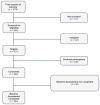Parent Outlook: How Parents View the Road Ahead as They Embark on Hematopoietic Stem Cell Transplantation for Their Child
- PMID: 26348891
- PMCID: PMC4706486
- DOI: 10.1016/j.bbmt.2015.08.040
Parent Outlook: How Parents View the Road Ahead as They Embark on Hematopoietic Stem Cell Transplantation for Their Child
Abstract
Pediatric hematopoietic stem cell transplantation (HSCT) offers cure for high-risk malignancies and other conditions, but carries a risk of complications. Parental outlook regarding their child's transplantation course and future health has been largely unexplored. This report presents the Parent Outlook Scale, describes its properties, and examines the outlook of parents embarking on their child's transplantation course and the associated variables. Parents of children scheduled to undergo HSCT (n = 363) at 8 US transplantation centers completed the Parent Outlook Scale, comprising 4 items assessing frequency of the parent's thoughts about the potential difficulty of the child's transplantation (Transplant Difficult subscale) and worsened health (Health Worse subscale). Item responses were rated on a 5-point Likert scale (ranging from "none" to "all of the time") and, along with scale/subscale scores, transformed to 100-point scales, with higher scores connoting greater thought frequency. Psychometrics were explored. Multivariable models identified personal and clinical characteristics associated with scale and subscale scores. The Parent Outlook Scale (α = 0.75) and subscales were found to have sound psychometric properties. Factor loading supported the single scale with 2 subscales representing distinct aspects of overall outlook. Mean scores (Parent Outlook, 52.5 ± 21.7; Transplant Difficult, 64.4 ± 25.6; Health Worse, 40.7 ± 25.7) revealed variability within and across scale/subscales. Significantly different mean subscale scores (P < .001) indicated more frequent Transplant Difficult thoughts than Health Worse thoughts. Clinical factors (solid tumor diagnosis and unrelated donor transplant) and a parent factor (worse emotional functioning) were associated with higher scale and subscale scores. Our findings show that the outlook of parents embarking on their child's HSCT course is varied and not solely a product of clinical factors readily apparent to clinicians. Referring and transplantation clinicians should create opportunities to explore with parents their perspectives and concerns before and during the course of HSCT.
Keywords: Health-related quality of life; Hematopoietic stem cell transplantation; Pediatrics; Supportive care.
Copyright © 2016 American Society for Blood and Marrow Transplantation. Published by Elsevier Inc. All rights reserved.
Conflict of interest statement
Conflict of interest statement: ■ ■ ■
Figures


Similar articles
-
Three sides to a story: Child, parent, and nurse perspectives on the child's experience during hematopoietic stem cell transplantation.Cancer. 2017 Aug 15;123(16):3159-3166. doi: 10.1002/cncr.30723. Epub 2017 Apr 7. Cancer. 2017. PMID: 28387946 Free PMC article.
-
Changing factors associated with parent activation after pediatric hematopoietic stem cell transplant.Support Care Cancer. 2015 Jul;23(7):1997-2006. doi: 10.1007/s00520-014-2544-1. Epub 2014 Dec 18. Support Care Cancer. 2015. PMID: 25519755 Free PMC article.
-
Stem cell transplant for children with sickle cell anemia: parent and patient interest.Biol Blood Marrow Transplant. 2012 Nov;18(11):1709-15. doi: 10.1016/j.bbmt.2012.05.013. Epub 2012 May 29. Biol Blood Marrow Transplant. 2012. PMID: 22659467
-
Assessment of health-related quality of life in pediatric hematopoietic stem cell transplant recipients: progress, challenges and future directions.Expert Rev Pharmacoecon Outcomes Res. 2013 Apr;13(2):217-25. doi: 10.1586/erp.13.11. Expert Rev Pharmacoecon Outcomes Res. 2013. PMID: 23570432 Free PMC article. Review.
-
Psychosocial factors and hematopoietic stem cell transplantation: potential biobehavioral pathways.Psychoneuroendocrinology. 2013 Nov;38(11):2383-93. doi: 10.1016/j.psyneuen.2013.06.016. Epub 2013 Jul 8. Psychoneuroendocrinology. 2013. PMID: 23845514 Free PMC article. Review.
Cited by
-
Falling Down the Rabbit Hole: Child and Family Experiences of Pediatric Hematopoietic Stem Cell Transplant.Qual Health Res. 2020 Jun;30(7):1125-1138. doi: 10.1177/1049732320912410. Epub 2020 Apr 4. Qual Health Res. 2020. PMID: 32249699 Free PMC article.
-
Thoughts from the threshold: patient and family hopes, fears, values, and goals at the onset of pediatric hematopoietic cell transplantation.Bone Marrow Transplant. 2020 Jun;55(6):1103-1113. doi: 10.1038/s41409-020-0794-8. Epub 2020 Jan 28. Bone Marrow Transplant. 2020. PMID: 31992844 Free PMC article.
-
What do pediatric transplant physicians think about palliative care? Results from a national survey study.Bone Marrow Transplant. 2025 Aug;60(8):1129-1136. doi: 10.1038/s41409-025-02597-z. Epub 2025 May 4. Bone Marrow Transplant. 2025. PMID: 40319195
-
Understanding the Relationship Between Child Health-Related Quality of Life and Parent Emotional Functioning in Pediatric Hematopoietic Stem Cell Transplant.J Pediatr Psychol. 2017 Aug 1;42(7):804-814. doi: 10.1093/jpepsy/jsx047. J Pediatr Psychol. 2017. PMID: 28369555 Free PMC article.
References
-
- MacMillan ML, Davies SM, Nelson GO, et al. Twenty years of unrelated donor bone marrow transplantation for pediatric acute leukemia facilitated by the National Marrow Donor Program. Biol Blood Marrow Transplant. 2008;14(9 Suppl):16–22. - PubMed
-
- Lee SJ, Klein J, Haagenson M, et al. High-resolution donor–recipient HLA matching contributes to the success of unrelated donor marrow transplantation. Blood. 2007;110:4576–4583. - PubMed
-
- Eckert C, Henze G, Seeger K, et al. Use of allogeneic hematopoietic stem cell transplantation based on minimal residual disease response improves outcomes for children with relapsed acute lymphoblastic leukemia in the intermediate-risk group. J Clin Oncol. 2013;31:2736–2742. - PubMed
-
- Eapen M, Rubinstein P, Zhang MJ, et al. Outcomes of transplantation of unrelated donor umbilical cord blood and bone marrow in children with acute leukaemia: A comparison study. Lancet. 2007;369:1947–1954. - PubMed
Publication types
MeSH terms
Grants and funding
LinkOut - more resources
Full Text Sources
Other Literature Sources

